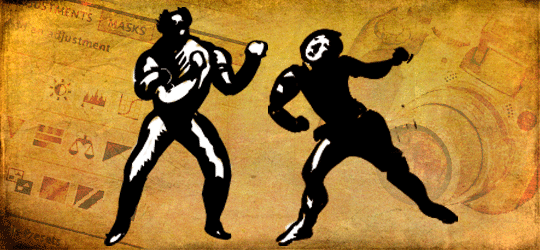
Go to any blog or forum that mentions post-processing and you will see a flurry of heated comments with those for and against duking it out. Since I have a blog on post-processing, it won’t be a stretch to guess which side of the boxing ring I’m in.
The Debate
There are those photographers that feel that all the creative process of photography should be done in-camera. Some even go so far as to think any post-processing such as sharpening or tonal corrections are cheating. I’ve seen comments to posts that loftily decry that they would never use Photoshop or any filters or plug-ins. I’ve seen descriptions on photographs that proudly claim that it is straight out of the camera (and they usually looked it—the photographs badly needed sharpening and tonal adjustments.) Then there are photographers who are fine with basic adjustments, but feel any creative interpretations of the image is not “true” photography and are cheating or lazy.
When Post-Processing is Lazy
Is there any truth that post-processing can be lazy? Sure. Technically, if you didn’t bother to use a tripod and shutter release when you should have and didn’t expose your image correctly when you could have—yes, that’s lazy. Trying to fix sins like this in Photoshop is not an ideal way to work. Creatively, if you slap a texture on an image or apply selective coloring just to try be different, the lack of artistic vision will show. (Note: I’m speaking of professional and artistic images, but if a person gets joy from making their snapshot a little more special with a simple effect, I say go for it!)
When is Creative Post-Production Inappropriate?
Any medical, crime or official photography would naturally need to remain un-manipulated. I think we can all see that documentary and journalistic photography would be unethical if it was photo-montaged to portray an untruth and it would probably be inappropriate to apply highly creative post-processing. Ethically, perhaps the line should be drawn at intent. Is the photograph meant to inform and convey reality or is it intended as an artistic expression?
Basic Image Editing
I can’t help but wonder if the pride associated with “Straight out of Camera” is something that has risen with the digital age. The ease of taking photographs and the ease of manipulating them has given need for people to want to distinguish and proclaim that indeed, they do know enough about photography that they took a good image to begin with. For anyone who ever printed their own work from negatives, we realize that there is no such thing as a negative that doesn’t need interpretation and 98% of the time, at least tonal adjustments with burning and dodging. Most serious photographers shoot in RAW format, which is basically a negative. Even the word RAW implies that there is more to be done with it—that it is not finished. I worked a year in a quick-print color lab and 8 years in a professional Black & White lab. I also have a degree in Fine Arts with an emphasis in photography and I studied photography with a former Ansel Adams assistant, so I know a bit about darkroom work. Even when you have your negatives printed at an automated lab, there is someone that looks them over and decides if they need more or less exposure and what color corrections are needed. Think about it. If you are saying that you won’t do any post-production corrections, you are giving your images less attention than they would get at a 1 hour photo lab! If you shoot in JPEG, then you are allowing your camera to make your decisions for you. That isn’t always a bad thing, but be aware of it. Most RAW images will need some sharpening.
Beyond Basic Editing
Post-production decisions have always been an integral part of the artistic vision. Photographers who printed their own work had many artistic decisions to make that were considered a normal part of the work-flow. What contrast paper to use, which developer to use, whether to use a toner like Sepia or Selenium and of course, your trusty burn and dodge tool kit was always by the enlarger. Ansel Adams is usually considered a champion of realistic photography, but he heavily interpreted his negatives. I once saw a before and after of Ansel’s famous Moonrise over Hernandez photograph. The difference between the contact print and the final is impressive. I managed to find it online here. I also found the notes Ansel made about printing it on the Notes on Photographs website. The notes are “translated” by John Sexton and worth the read. The following is an excerpt from his text:
Ansel felt that the printing process was integral to the creative process in photography. Nearly all of Ansel’s prints require considerable interpretation from the basic straight print. Ansel was a master at transforming his negatives into prints that fulfilled not just what he saw, but also what he felt when making the photograph.
Related: Nice article I found on Outdoor Photography: Legacy: Think Like Ansel Adams Today, Tools and aesthetics have changed, but the techniques of the great American landscape master still apply.
Before or After—Does it Matter?
When you think about it, why should it make a difference if an effect is applied in front of the camera or after in post-processing? Is there more integrity to put up a painted background for a portrait shot than to apply a texture afterward? When you set up lights, use barn doors, put a filter over your flash, etc. you are artificially controlling what you shoot. Why is it “wrong” to artificially control your image in post-processing? In the days of film, a certain film was chosen not only for the shooting speed of the ASA, but also for the look of the film. People shot with 1000 ASA to get a textured and grainy effect, there were huge fans of Fuji NPS 160 film for portrait and wedding photography and fans of Fuji Velvia for its saturation and vibrancy. Is it any different today to apply a Photoshop filter or action or texture that gives a similar effect?
When Is Post-Processing No Longer Photography?
Ah, here is perhaps the crux of the debate. Is it no longer photography when post-processing ranges far into illustrative techniques? Is it only photography when the creativity rests primarily on the camera side?
In this Corner — Straight Photography
I can understand the pride of skill and joy a photographer takes from “Straight” photography. I always appreciate enormously gorgeous nature photographs with careful lighting. It is, however, only one approach to photography. Far from being lazy, mastering digital skills require an enormous time investment and also has pride of skill.
Creative Post-Processing — A Long Tradition in Photography
From the beginning, photography has had techniques and artists who push the boundaries of photography. When I think about it, is there really a norm for photography? In flipping through the book Looking at Photographs by Gordon Baldwin*, I’m impressed with the many techniques that have been employed: Cyanotpye, Collage, Double-Exposure, Solarization, Combination Prints, Gum Bichromates, Hand-Coloring, Negative prints, Orotones, and Photogenic drawing to name a few. I can also remember Polaroid transfers, Polaroid SX-70’s, and reticulation. Personally, on prints I have used everything from ink, oils, dyes, paint, pencils, pumice powder and rubber cement to achieve a look I wanted.
Creative Fads
There will always be movements in art. As technology changes artists will always explore new mediums and artists will always search for new vocabularies to portray their artistic vision. As with any movement, there will always be those that jump on board looking for a substitute to vision. With time, the best work will remain and the rest will drop away. I’m sure for every Van Gogh and Monet there were those that jumped on the Impressionistic wagon that we never heard about. There will always be resistance to new movements as well. Impressionism was considered a fad and an abomination to painting.
I’ve seen textures, selective coloring, photo-montage, the Orton effect and other current techniques called fads. Yes, they can be that, but they are just tools that we use. Like any tool it is how each artist uses it that determines the outcome. We’re in a time of discovery. It used to be out of most of our reach to explore color photography. I think it’s a natural part of our collective discovery that sometimes we are probably going to go too far—and that’s OK. I find the current technology to be tremendously liberating. The benefits of freedom of expression and exploration—the opportunity for revolutionary image-making—far out-weigh the pitfalls.
Conclusion
We should strive to take photographs with a solid foundation of technique. There is the old adage that you must know the rules to break them. Ben Shahn wrote in The Art of Content:
Craft is that discipline that frees the spirit; and style is the result.
Beyond that, what creative technique we use is purely what appeals to us as individuals. We gravitate to techniques that appeal to both our physical working preferences and to our unique skill backgrounds. Some photographers revel in being at the top of the mountain at 5AM to be ready for the dawn light, some love perfecting studio strobe lighting, some will lie patiently prostrate, cramped on the wet ground, waiting for a dragonfly to show up near a flower, and some prefer to carefully set up compositions in the studio and then spend hours refining their vision with software and painting skills.
Today, digital photography and computer arts have blown the possibilities wide open and there is more of a bleeding between photography and illustration. What do you think? Does there come a point when it’s no longer a photograph? I welcome your opinions—even if they are different than mine. Let’s be nice about it though.
*Amazon.com affiliate link.
American Photographer and Designer living in France with my French husband, 2 Weimaraners and Cat Rescues. Camera, Mac, studio, garden.




A wonderfully written article. I agree wholeheartedly. Similar debate crops up concerning HDR photography, yes? It’s new, it’s different, but that doesn’t automatically make it bad.
As to the question of when a photograph becomes illustration or some other form of art apart from photography, I’m not sure. I consider myself an artist first, and photography as something I use in my art. So to me the whole argument seems very subjective, very relative.
Phoebe Baker recently posted..Avatar- The Last Airbender
Very well written and thought out article.
I couldn’t agree more with Phoebe “posted above.”
Straight Photography VS Creative Post-Processing, the debate will unfortunately always be there, but it’s really grown tiresome, the same as PC or Mac, give it a rest and learn to embrace the differences.
Art is art, no matter what tools or techniques are applied, and everyone has an opinion, but that doesn’t mean one should criticize others,if you don’t like something, just quit watching and change the channel.
Jerry recently posted..Vintage Oil Painting Texture Set Tutorial